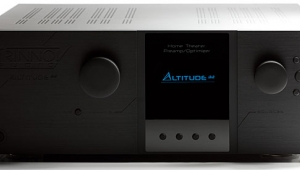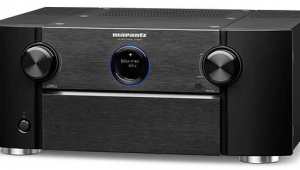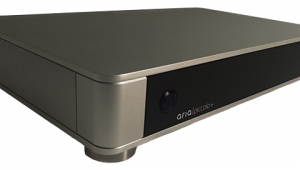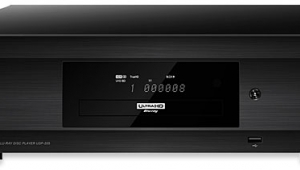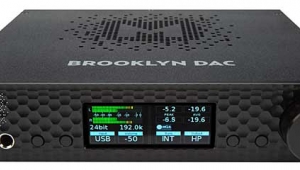| Columns Retired Columns & Blogs |
Music in the Round #3
Bass management? We don't need no stinking bass management. We use full-range speakers all around!
Well, that's what many people think when faced with assembling a multichannel music system.
SACD's original specification was for five identical full-range speakers for the five main channels and, if the program material called for it, another channel for subwoofer, LFE, height, and/or other effects. Bass management, whereby some of the bass from the main channels could be redirected to the subwoofer, was grudgingly permitted for those saddled with constraints of space, money, and/or spouse that prevented their having six large enclosures in the listening room. DVD-Audio, the prodigal son of the DVD-Video spec, was less dogmatic from the beginning, and assumed that most listeners would use smaller speakers, supplemented by a subwoofer or two to do the heavy lifting. As a result, fewer early SACD players had much in the way of bass management compared to early DVD-A players.
However, before one relegates to lower status systems with small monitors and subs, consider that speaker placement is an even more important variable in a multichannel setup than it is for two-channel stereo. If you want to maintain roughly equal speaker-to-listener distances and the recommended ITU angular arrangement—see the June 2003 "Music in the Round"—you no longer have much freedom to place your speakers for optimum bass performance. In other words, unless you're very lucky in your room arrangements and in your choice of significant other, the extended bass of which your full-range behemoths may be capable—and for which you paid dearly—will not be realized. You'll be forced to use a sub after all.
I still advocate full-range speakers all around—or, at least, speakers with extension to below 50Hz—because you want to get the crossover to the sub as low as possible to prevent it from being audibly localizable, and for this, the main speakers must extend deep enough. You also want good power-handling right down to that rolloff to ensure full midbass and integration with the sub. In other words, those cute little pods and spheres that can't extend down into two-digit frequencies are beneath our consideration.
Until recently, however, all of this was theoretical to me. My Paradigm Reference Studio/60 and Studio/20 speakers have decent bass, and even the Studio CC center extends to just under 50Hz. Unfortunately, the Studio CC sits on a TV and the Studio 20s, with their rear-firing ports, nestle in my room's rear corners. So when I set up the Meridian Reference 800 DVD-A transport and 861 surround processor in this system, I was not surprised to find that crossing over the Studio CC and Studio/20s at about 65Hz unmuddied the bass to a substantial degree. The front L/R Studio/60s needed no such assistance, but I count myself lucky that their placement for best imaging also works pretty well for the low frequencies.
"But I like big speakers..."
That's what I pleaded when Magnepan's Wendell Diller tried to force a Home Theater Set (four wall-mount MGMC1 panels and a CC3) on me. What I really wanted was MG3.6/Rs all around, but my room can't accommodate them. And I anticipated problems with Magnepan's Home Theater Set because: 1) none of the speakers goes below 80Hz; 2) every multichannel player has different varieties of bass management, thus skewing any comparisons among them; 3) the resident analog preamps had no bass management; and 4) my wife would not be happy about the screw-holes in the walls when the Maggies were dismounted.
 Salvation came in two ways. First, Diller offered to fly out to Connecticut (on July 4, no less!) and rig up some floor and ceiling jacks to support the MGMC1s. While my wife is greatly pained by how ugly the jacks are, even she admitted that they were a canny solution that would leave no marks. Second, I got Outlaw Audio to send me their ICBM (for Integrated Controlled Bass Manager) so that all inputs and sources could share the same bass-management circuitry and enjoy a level playing field.
Salvation came in two ways. First, Diller offered to fly out to Connecticut (on July 4, no less!) and rig up some floor and ceiling jacks to support the MGMC1s. While my wife is greatly pained by how ugly the jacks are, even she admitted that they were a canny solution that would leave no marks. Second, I got Outlaw Audio to send me their ICBM (for Integrated Controlled Bass Manager) so that all inputs and sources could share the same bass-management circuitry and enjoy a level playing field.
The MGMC1 is a small (46" H by 10.25" W by 1" D), two-way planar-magnetic speaker with a quasi-ribbon tweeter running the full height along the outer edge. Pins extend from the upper and lower ends of the MGMC1's inner edge; when these are inserted in the provided mounting brackets, the speaker can be pivoted on them, enabling the user to aim the speaker or, when it's not in use, to fold it out of the way. As a result, an MGMC1 always has one edge at the wall; Magnepan rates them down to 80Hz only with such boundary placement.
Magnepan also says to set "your processor or receiver to 'small speaker'," confirming the need for bass management. However, since the MGMC1 is a dipole, radiating half its sound from its rear surface, its tonal balance will be greatly influenced by surrounding objects and materials. On the other hand, readjusting the speaker's angle with respect to the wall also allows the user to tune the tonal character imposed by the surroundings. This turned out to be quite useful.
I used the Outlaw ICBM to redirect sub-80Hz bass from the Maggies to a Paradigm Servo-15 subwoofer, the Bel Canto Pre6 multichannel preamplifier (see below) (to tune the interchannel balance), and the Bel Canto eVo6 power amplifier to provide the muscle. Later, I swapped out the eVo6 for the Adcom GFA-7805, as part of the preparation for a forthcoming review. Wendell Diller placed the front left and right MGMC1s symmetrically on the front wall but, like most rooms in most real homes, the features in mine make it asymmetrical. The left speaker had an equipment rack about 1.5' to its left, but the right speaker had a doorway the same distance to its right. The only way to balance them was to make sure the door was kept closed for serious listening, boost the right channel by +2dB to compensate for the speaker's greater distance from the corner, and angle the right speaker a bit off-axis to the listening seat to compensate for the reflections off the back of the door. This may sound complex and tedious, but it indicates that the Magnepan's design was smart enough to permit such tuning.
The rear MGMC1s needed similar attention: my room's windows and drapes prevented their symmetrical placement as well. The right rear speaker was mounted to the side wall about 2.5' from the rear corner, but the left one was mounted to the rear wall only a bit more than 1' from the corner. In effect, the left rear MGMC1 aimed its rear radiation directly into a well-draped corner, thus enjoying considerable gain in the lower midrange and bass, while the right rear MGMC1 could take advantage of only a bit of corner loading. Here, again, judicious re-angling compensated well for the tonal imbalance, and the corner loading was equalized with respect to the front speakers: -3dB for the right rear, -9dB (!) for the left rear.
- Log in or register to post comments


